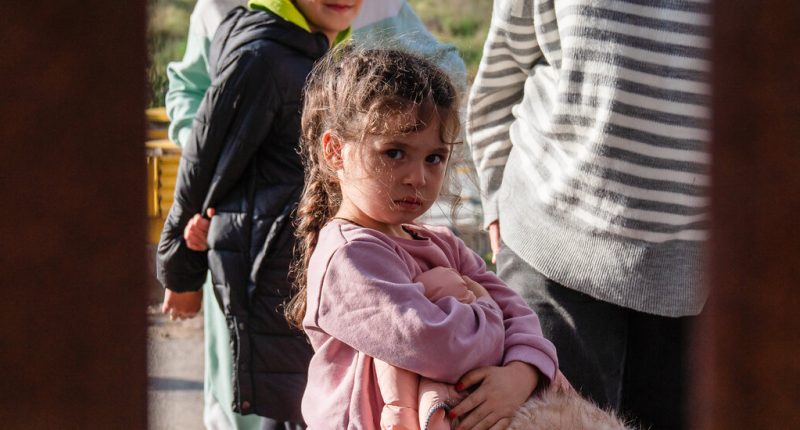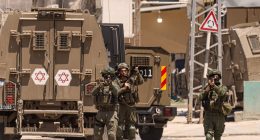To Dr. Theresa Cheng, the scene was “apocalyptic.”
She had come to Valley of the Moon, an open-air holding site in San Diego’s rural Mountain Empire, to provide volunteer medical care to asylum seekers who had breached the United States-Mexico border wall and were waiting to be apprehended by American authorities.
Among the throngs at this and other sites, she found children with deep lacerations, broken bones, fevers, diarrhea, vomiting, even seizures. Some were hiding in dumpsters and overflowing porta-potties. An asthmatic boy without an inhaler was wheezing in the acrid smoke from brush and trash fires, which had been lit for warmth.
With the capacity at immigration processing centers strained, migrants, including unaccompanied children, are waiting for hours — sometimes days — in outdoor holding areas, where a lack of shelter, food, and sanitation infrastructure has triggered an array of public health concerns for the most vulnerable.
“From a public health standpoint, there are communicable diseases and outdoor exposures that would strike anyone down, much less this medically vulnerable population,” said Dr. Cheng, an emergency room physician at Zuckerberg San Francisco General Hospital and Trauma Center.
A Federal District Court judge in California could rule as early as Friday on whether the government is legally required to shelter and feed the children as they wait.
In a court filing, lawyers for the Department of Justice argue that because the children have not yet been formally taken into custody by U.S. Customs and Border Protection, they are not obligated to provide such service.
“Minors in these areas — close to the California-Mexico border — have not been arrested or apprehended by C.B.P. and are not in the legal custody of C.B.P.,” the lawyers wrote.
“C.B.P. has been apprehending and transporting minors to safe and sanitary U.S. Border Patrol facilities in a prompt manner. But until that occurs, plaintiffs are not in D.H.S. custody,” they wrote, referring to the Department of Homeland Security.
When asylum seekers enter the United States between official ports of entry, they often present themselves to Border Patrol agents near the wall with the intention of being apprehended. They are taken to a processing facility, where they receive a medical screening, a background check and basic provisions as they begin the legal claims process.
But unlike at those immigration processing facilities, the open-air sites have no shelters, meals or government-affiliated medical staff. Some sites have no restrooms, causing people to defecate outdoors in the open, according to Erika Pinheiro, the executive director of the legal and humanitarian nonprofit Al Otro Lado, who has provided aid at the camps. With limited diapers, wipes and creams from volunteers, babies have been kept in dirty diapers for extended periods of time, according to court exhibits, causing severe diaper rash.
A senior official at Customs and Border Protection acknowledged in an interview that people had at times waited days to enter processing but said that vulnerable groups like children were always prioritized, and that wait times had decreased significantly in recent months. He said the agency had more than tripled the capacity at processing centers in San Diego and that it had increased the number of transport buses and personnel in order to expedite apprehensions.
Still, he said, the system was not built for migrant encounters at the current scale, and the shift of crossings to more remote regions has made the process all the more resource-intensive, since vehicles and personnel must travel further between encampments and Border Patrol stations. He said a major increase in federal funding would be necessary to address the problem fully.
At least seven migrant holding areas have arisen at various points along the California border. One is a large patch of dirt in the desert beside a highway; another is a plateau in mountainous wilderness; another is the narrow gap between two parallel border walls that have been erected just feet from the Mexican city of Tijuana.
None of the holding areas were formally established by immigration officials, but they have become a pillar of their operations — makeshift camps where they instruct asylum seekers to line up for count, remove their shoelaces, strip down to one layer of clothing and wait.
Adriana Jasso, who runs a volunteer aid station against the steel slats of the border wall in San Ysidro, Calif., on behalf of the nonprofit American Friends Service Committee, said the lack of food, water, and baby formula provided by the government has been particularly concerning. “There is no logic if the most powerful country in the history of humanity, the country with the highest concentration of wealth, is not able to provide for basic needs of children,” she said.
Migrant advocacy groups have filed multiple complaints with the Office for Civil Rights and Civil Liberties at the Department of Homeland Security, and a group of lawyers who represent children in immigration custody as part of a 1997 federal court agreement known as the Flores settlement have taken to the courts over the conditions.
The Flores settlement agreement established the standards of treatment for immigrant children who are detained by the government. It essentially requires that children in immigration custody have rights and protections similar to those of children within the welfare system inside the country, and that they are released from detention to an appropriate sponsor, such as a parent or relative, “without unnecessary delay.”
Plaintiff lawyers in the settlement, including the Oakland-based nonprofit National Center for Youth Law, have filed a new motion to enforce the terms of Flores for young migrants who are still awaiting processing in the open air. They argue that the children waiting against the border wall deserve the same safe and sanitary housing as those already in official custody, since they are forbidden from moving from the camps and have no way of going back.
The burden of medical issues among children in the holding areas is difficult to measure, since volunteers are only permitted at the sites at the discretion of border agents, and a hodgepodge of aid groups does not keep a collective record of wounds treated or electrolytes dispensed.
In a December 2023 email to federal officials, a lawyer wrote that infants in the holding areas had begun vomiting because of severe dehydration, and that some children had been given one granola bar for sustenance per day. Pedro Rios, the director of the American Friends Service Committee’s U.S.-Mexico Border program, said he had encountered migrants who had been eating leaves because they had been there for five days without food, as well as mothers who had stopped producing breast milk because of traumatic stress and infants with no formula to replace it.
Hundreds of children have been gathered at the sites each month since last summer, and Dr. Cheng, who is also a professor of emergency medicine at the University of California, San Francisco, estimated that she had evaluated or treated 100 children in one week alone. She encountered a 5-year-old and 12-year-old who had spent three nights outdoors; an 8- or 9-year-old to whom she gave facial stitches out in the open air; a 13-year-old boy with a traumatic injury, blood pouring from his ears and nose.
Children are not the only migrants with serious health issues. In remote swaths of eastern San Diego County, those who turn themselves in to border authorities have often endured arduous journeys through steep mountainous terrain and desert land, arriving at the holding areas in deteriorated health. Doctors said they encountered a man with a kidney transplant who was running out of immunosuppressants, a woman with a traumatic stroke who could not reach her own shoelaces, and a migrant who had traveled with an oxygen concentrator and had become hypoxic. He eventually died.
Doctors are particularly concerned about cases of hypothermia among children, since many have lower body fat than adults and may be malnourished from their journeys. Migrants have been soaked by heavy rainfall in the waiting areas overnight, which can cause the body temperature to plummet. Two minors were hospitalized for hypothermia last month.
Karen Parker, a retired social worker in Boulevard, Calif., who does volunteer medical triaging at the eastern camps, said that, in addition to broken feet and twisted ankles, she routinely encounters unaccompanied minors having panic attacks. “The stress, the exhaustion, the trauma is making them physically sick,” she said. “I’m looking at them, thinking they are finally here, but their eyes are so vacant.”
The number of people and duration of wait times has fluctuated since last summer. In recent weeks, Mexican military activity has pushed migrants toward the west, a more urban region between Tijuana and California’s San Ysidro where asylum seekers who breach the primary border wall must wait for federal agents in the 280-foot space behind a second one. Fewer gaps in the primary border wall there mean more children are hauled over it or smuggled under it, despite concertina wire. Aid workers have documented an increase in deep head gashes, and local neurosurgeons have reported a rise in traumatic injuries.
In recent weeks, a 3-year-old and a 1-year-old have both fallen from the border wall in their parents’ arms.
“When you hear the babies just crying and crying, right on that other side of this wall, that’s the worst part,” said Clint Carney, the government affairs manager for the nonprofit Survivors of Torture, International, who provides aid through the slats in the border wall.
Local E.M.S. teams have been inundated with calls from the sites, and aid workers said that federal agents had often denied their requests to dial 911, suggesting migrants were faking injuries. Those who encountered serious injuries often called volunteer medical staff to advise them by phone.
When Dr. Cheng got one such call on a recent morning and arrived at the scene to find a 13-year-old boy with a weak pulse and blood pouring from his ears and nose, two border agents were standing nearby but had not taken any steps to assist, she said in court documents.
Dr. Cheng performed CPR, but it took an hour for emergency services to arrive, she said. The boy died.
Also Read More: World News | Entertainment News | Celebrity News








